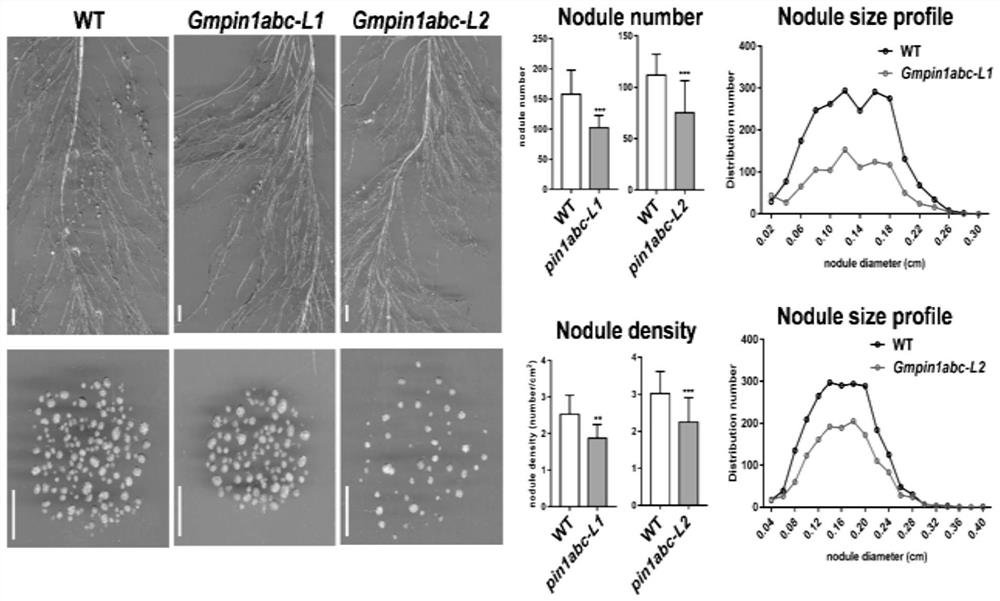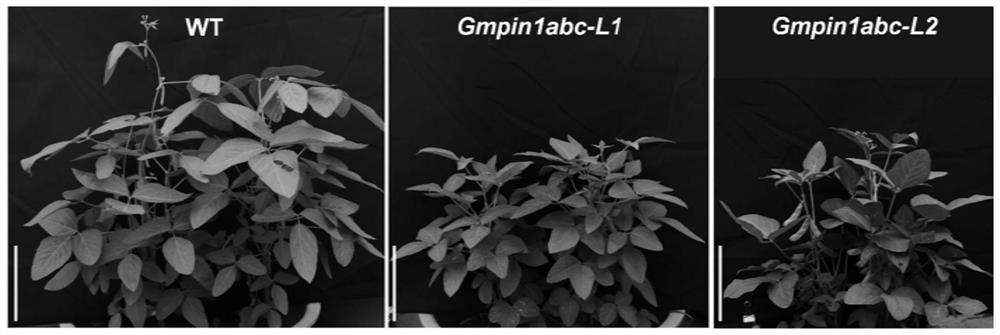A method for regulating soybean nodulation and dense planting by gmpin1 gene mutation and its application
A gene mutation and soybean technology, applied in the field of plant genetic engineering, can solve the problem of few reports of major genes
- Summary
- Abstract
- Description
- Claims
- Application Information
AI Technical Summary
Problems solved by technology
Method used
Image
Examples
Embodiment 1
[0045] Wild-type soybean (WT) and soybean triple mutant Gmpin1abc were bred in the following manner.
[0046] The light duration between soybean growth was 14 hours and the temperature was 25°C. Soybean seeds were germinated on vermiculite. On the 7th day after seed germination, the rhizobia BXYD3 with an OD value of 0.15 was evenly watered from the vermiculite surface to the soybean roots, followed by 1 / 10 nitrogen hydroponic solution for moisturizing and continued cultivation for 14 days.
[0047] The formula of 1 / 10 nitrogen hydroponic solution is shown in the following table:
[0048] Element KNO 3
[0049] The nodulation phenotypes of wild-type soybean (WT) and Gmpin1abc gene-edited soybean triple mutants are as follows figure 2 Gmpin1abc showed an overall decrease in nodule number and a decrease in nodule density (number of nodules divided by root area), but no significant change in the mean diameter of nodule nodule size profile. Number, density and di...
Embodiment 2
[0051] Wild-type soybean (WT) and soybean triple mutant Gmpin1abc were bred in the following manner.
[0052] The light duration between soybean growth was 14 hours and the temperature was 25°C. Soybean seeds were germinated on vermiculite. On the 10th day after the germination of the seeds, they were transferred into soil mixed with nutrient soil and loess and planted outdoors for 45 days.
[0053] Plant phenotypes of wild-type soybean (WT) and Gmpin1abc gene-edited soybean triple mutants are shown in the appendix image 3 As shown; the 10-day-old seedlings were transplanted into the soil and the overall plant type was short after 45 days of outdoor growth, and the angle of the lateral branches was reduced.
[0054] Lateral branch phenotypes of wild-type soybean and Gmpin1abc-L1 gene-edited soybean homozygous triple mutants Figure 4 shown; the branch angle of the homozygous triple mutant soybean Gmpin1abc-L1 without the CRISPR / Cas9 vector fragment was significantly reduce...
PUM
 Login to View More
Login to View More Abstract
Description
Claims
Application Information
 Login to View More
Login to View More - R&D
- Intellectual Property
- Life Sciences
- Materials
- Tech Scout
- Unparalleled Data Quality
- Higher Quality Content
- 60% Fewer Hallucinations
Browse by: Latest US Patents, China's latest patents, Technical Efficacy Thesaurus, Application Domain, Technology Topic, Popular Technical Reports.
© 2025 PatSnap. All rights reserved.Legal|Privacy policy|Modern Slavery Act Transparency Statement|Sitemap|About US| Contact US: help@patsnap.com



